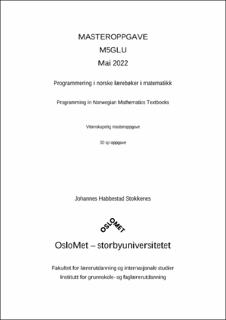| dc.description.abstract | Denne masteroppgaven handler om programmering i matematikkfaget. I arbeidet med Fagfornyelsen ble det fastsatt nye læreplaner i norsk skole, og det ble vedtatt at programmering skulle bli en integrert del av matematikkfaget. Programmering skal fungere som et verktøy for å utforske og løse problemer i matematikkfaget, samt være et viktig verktøy for å sikre elevenes opplæring i algoritmisk tenkning. I denne oppgaven ser jeg nærmere på hva som karakteriserer programmeringsinnholdet til et utvalg læreverk i matematikk, der i hovedsak oppgavene er grunnlag analysen. Læreverkene er laget i henhold til Fagfornyelsen, og bøkene som er inkludert i analysen strekker seg mellom 5-10.trinn. Analysen tar utgangspunkt i følgende to forskningsspørsmål:
1. Hva karakteriserer programmeringsinnholdet i norske lærebøker i matematikk på mellom-og ungdomstrinnet?
2. På hvilken måte legger programmeringsoppgavene til rette for å få frem eller skape sammenhenger mellom programmering og matematikk?
For å besvare forskningsspørsmålene har jeg analysert lærebøkene ved hjelp av et analyseverktøy, inspirert av Bråting & Kilhamns (2021) analyse av programmeringsinnholdet i svenske lærebøker, som baserer seg på to rammeverk innenfor programmering og algoritmisk tenkning. I oppgaven presenteres teori om programmering, algoritmisk tenkning og programmering i matematikk. Datagrunnlaget for analysen består av 276 oppgaver fra totalt elleve bøker. Resultatene og diskusjonen viser at handlingen følge og forme og skape er de mest fremtredende i lærebøkene. Og at begrepene steg-for-steg instruksjoner, kode og algoritme var oftest inkludert i oppgavene. Enkelte sentrale ferdigheter og begreper innenfor algoritmisk tenkning og programmering var overraskende lite inkludert i oppgavene, som feilsøking/debugging. Lærebøkene inneholder oppgaver som kan gi elevene mulighet til å bruke programmering til å utforske matematiske begreper og idéer, men slike oppgaver er det relativt sjeldne.
This master´s thesis is about programming in the school subject mathematics. In the renewal of the national curricula in 2020 in Norway, it were decided to implement programming as a part of mathematics. Programming should be used as a tool to explore and solve problems in the subject of mathematics. In addition to work as an important tool to teach computational thinking. In this thesis I take a closer look at what characterizes the programming content in a selection of Norwegian mathematics textbooks from grades 5-10, where the tasks are mainly the foundation for the analysis. All the textbooks included in the analysis is made after the new curricula implemented in 2020. The following two research questions will be discussed:
1. What characterizes the programming content in Norwegian textbooks in school mathematics?
2. In what way does the programming tasks create a bridge between programming and mathematics?
In order to answer these research questions I’ve analyzed the textbooks using a analytical tool, inspired by Bråting & Kilhamn´s (2021) analysis of the programming content in Swedish mathematics textbooks, which is based on two theoretical frameworks which includes actions and concepts that are important for teaching in computational thinking and programming. The thesis presents theory about programming, computational thinking and programming in mathematics. The data basis for the analysis consists of a total of 276 tasks from the in total eleven books. The results and discussion reveals that the action follow and form and create are the two most prominent in the textbooks. And the concepts stepwise instructions and algorithm were most often included in the tasks. In addition, the results show that important and basic computational concepts, such as debugging, are rarely included in the tasks. The textbooks contains some tasks that gives the students the opportunity to use programming to explore mathematical concepts and ideas. Although, these types of tasks are relatively rare. | en_US |
